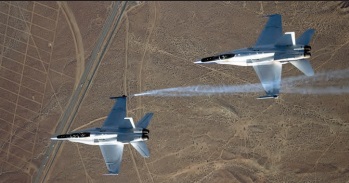Chapter: Efficient Aerospace Vehicle Technologies, new invention technology, Research project papers,
Data Fusion to Estimate Vortex Location for Drag Reduction in Formation Flight

Data Fusion to
Estimate Vortex Location for Drag Reduction in Formation Flight
NASA is investigating
the potential benefits of flying aircraft in the aerodynamic wake vortex
emanating from a lead aircraft's wing tip. Analytic studies predict that a
trailing aircraft in the updraft portion of a wake vortex may experience drag
reductions of 15 percent or more by gaining additional lift. One of the
technical challenges is finding the
optimal position
within the vortex to fly. This Armstrong research project is evaluating a
methodology that fuses data from existing sensors to estimate the optimal
position.
Work to date: A proof-of-concept
simulation has demonstrated improvement in vortex estimation when
combining data from the aircraft's moment and fuel flow sensors.
Looking ahead: Near-term work
involves building software to perform data fusion with real-time
measurements. Longer-term goals are to evaluate the approach on an actual
flight test and then a live demonstration of formation flight for drag
reduction and fuel savings.
Benefits
Improves accuracy: In simulations,
data fusion of moment and fuel flow sensors more accurately estimates the
vortex core than do data from the individual sensors.
Increases efficiency: Improved
accuracy will result in greater drag reduction and fuel savings.
Applications
Military formation flying
Commercial
formation flying UAV swarming
Efficient Aerospace Vehicle Technologies
Increasing efficiency in aerospace systems is a key goal across
the spectrum of NASA operations.
Armstrong researchers are constantly striving to build
efficiency into all phases of flight projects, through development,
fabrication, and operations processes.
From a new wing design that could exponentially increase total
aircraft efficiency to a novel test stand for single-engine electric aircraft,
our researchers are finding unique solutions that increase efficiency.
Related Topics